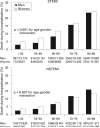The joint contribution of sex, age and type of myocardial infarction on hospital mortality following acute myocardial infarction
- PMID: 19147625
- PMCID: PMC3065924
- DOI: 10.1136/hrt.2008.155804
The joint contribution of sex, age and type of myocardial infarction on hospital mortality following acute myocardial infarction
Abstract
Objective: Younger, but not older, women have a higher mortality than men of similar age after a myocardial infarction (MI). We sought to determine whether this relationship is true for both ST elevation MI (STEMI) and non-ST elevation MI (NSTEMI).
Design: Retrospective cohort study.
Setting: 1057 USA hospitals participant in the National Registry of Myocardial Infarction between 2000 and 2006.
Patients: 126 172 STEMI and 235 257 NSTEMI patients.
Main outcome measure: Hospital death.
Results: For both STEMI and NSTEMI, the younger the patient's age, the greater the excess mortality risk for women compared with men, while older women fared similarly (STEMI) or better (NSTEMI) than men (p<0.0001 for the age-sex interaction). In STEMI, the unadjusted women-to-men RR was 1.68 (95% CI 1.41 to 2.01), 1.78 (1.59 to 1.99), 1.45 (1.34 to 1.57), 1.08 (1.02 to 1.14) and 1.03 (0.98 to 1.07) for age <50 years, age 50-59, age 60-69, age 70-79 and age 80-89, respectively. For NSTEMI, corresponding unadjusted RRs were 1.56 (1.31 to 1.85), 1.42 (1.27 to 1.58), 1.17 (1.09 to 1.25), 0.92 (0.88 to 0.96) and 0.86 (0.83 to 0.89). After adjusting for risk status, the excess risk for younger women compared with men decreased to approximately 15-20%, while a better survival of older NSTEMI women compared with men persisted.
Conclusions: Sex-related differences in short-term mortality are age-dependent in both STEMI and NSTEMI patients.
Figures


References
-
- American Heart Association . Heart disease and stroke statistics: 2003 update. American Heart Association; Dallas: 2002.
-
- Vaccarino V, Parsons L, Every NR, et al. Sex-based differences in early mortality after myocardial infarction. National Registry of Myocardial Infarction 2 Participants. New Engl J Med. 1999;341:217–25. - PubMed
-
- Rosengren A, Spetz CL, Koster M, et al. Sex differences in survival after myocardial infarction in Sweden; data from the Swedish National Acute Myocardial Infarction Register. Eur Heart J. 2001;22:314–22. - PubMed
-
- Vaccarino V, Krumholz HM, Yarzebski J, et al. Sex differences in 2-year mortality after hospital discharge for myocardial infarction. Ann Intern Med. 2001;134:173–81. - PubMed
-
- Mahon NG, McKenna CJ, Codd MB, et al. Gender differences in the management and outcome of acute myocardial infarction in unselected patients in the thrombolytic era. Am J Cardiol. 2000;85:921–6. - PubMed
Publication types
MeSH terms
Grants and funding
LinkOut - more resources
Full Text Sources
Medical
